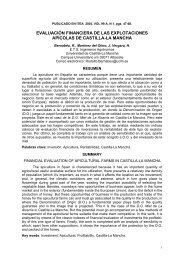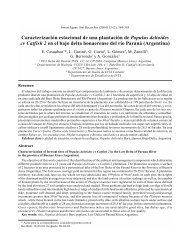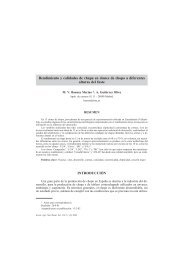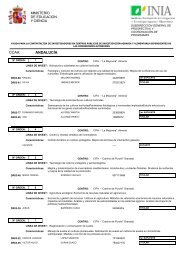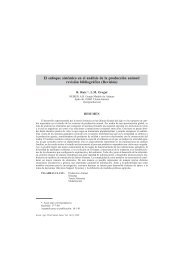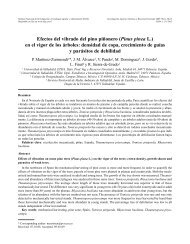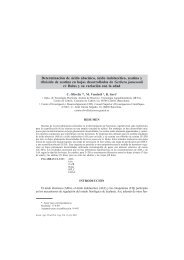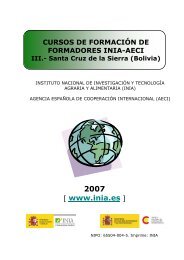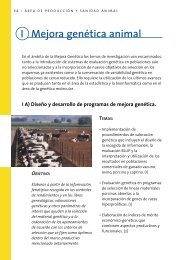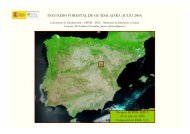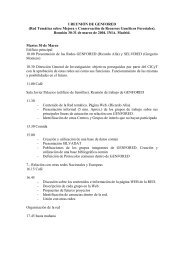Status of medicinal and aromatic plants in - Inia
Status of medicinal and aromatic plants in - Inia
Status of medicinal and aromatic plants in - Inia
Create successful ePaper yourself
Turn your PDF publications into a flip-book with our unique Google optimized e-Paper software.
PRESENTED PAPERS 65<br />
The regional laws to protect flora are more or less severe accord<strong>in</strong>g to regions. In most<br />
regions the harvest<strong>in</strong>g <strong>of</strong> unprotected species <strong>and</strong> <strong>of</strong> <strong>plants</strong> grow<strong>in</strong>g outside protected areas<br />
is unrestricted. On the contrary <strong>in</strong> other regions, <strong>in</strong> addition to a list <strong>of</strong> protected <strong>plants</strong><br />
whose harvest is forbidden, severe limitations <strong>in</strong> the collection <strong>of</strong> other species are also<br />
provided <strong>and</strong> only a few specimens are allowed. Derogations to these restrictions are<br />
provided only for scientific, pharmaceutical, <strong>medic<strong>in</strong>al</strong> or educational purposes, but <strong>in</strong> any<br />
case harvest<strong>in</strong>g needs an authorization. The regional law <strong>of</strong> Veneto does not provide<br />
derogations for "<strong>medic<strong>in</strong>al</strong>" purposes <strong>and</strong> as a consequence, <strong>in</strong> this region, MAP collect<strong>in</strong>g is<br />
forbidden. The only exception is wild asparagus, <strong>of</strong> which you may harvest 1 kg/day.<br />
In the regional lists <strong>of</strong> protected <strong>plants</strong> you may also f<strong>in</strong>d some "classic" MAPs (Table 4)<br />
among which Dictamus albus L., Gentiana lutea L. <strong>and</strong> two species <strong>of</strong> Ruscus (R. aculeatus L.<br />
<strong>and</strong> R. ipoglossum L.) are the most frequently recurr<strong>in</strong>g.<br />
Table 4. MAPs present <strong>in</strong> the lists <strong>of</strong> protected <strong>plants</strong> <strong>in</strong> different Italian regions<br />
Genus<br />
Species<br />
Val d'Aosta<br />
Piedmont<br />
Liguria<br />
Lombardy<br />
Veneto<br />
Trent<strong>in</strong>o<br />
Alto Adige<br />
Friuli V.G.<br />
Emilia Rom.<br />
Tuscany<br />
Umbria<br />
Marche<br />
Lazio<br />
Campania<br />
Abruzzo<br />
Calabria<br />
Achillea erba-rotta All. X<br />
Aconitum sp. X X<br />
Arnica montana L. X (1) X X (2) X<br />
Artemisia laxa F. X<br />
Artemisia<br />
umbelliformis<br />
Lam<br />
X<br />
Atropa bella-donna L. X X (4) X<br />
Crocus sp. X X X<br />
Dictamus albus L. X X X X X X X X X X<br />
Gentiana sp. X (1) X X X X X X X X X X<br />
Glycyrrhiza glabra L. X<br />
Hyssopus <strong>of</strong>fic<strong>in</strong>alis L. X X X<br />
Iris sp. X X X X X<br />
Juniperus sp. X X<br />
M<strong>and</strong>ragora autumnalis Bert. X<br />
Myrtus communis L. X<br />
Paeonia <strong>of</strong>fic<strong>in</strong>alis L. X X X X X X X X X<br />
Pistacia lentiscus L. X<br />
Ruscus sp. X X X X X X (2) X (3) X X X<br />
Solidago<br />
virgaurea subsp.<br />
littoralis (Savi)<br />
X<br />
Burnat<br />
Taxus baccata L. X X X X X X<br />
Thymus vulgaris L. X<br />
Urg<strong>in</strong>ea maritima Bak. X (4)<br />
Viscum album L. X<br />
(1) It is allowed to collect 6 flower<strong>in</strong>g stems per day/person <strong>and</strong> 24 flower<strong>in</strong>g stems per groups >3 people<br />
(2) It is allowed to collect daily 1 kg <strong>of</strong> edible, fresh parts per person<br />
(3) It is allowed to collect daily 10 flower<strong>in</strong>g stems/person<br />
(4) A collect<strong>in</strong>g authorization is needed<br />
Instead <strong>of</strong> referr<strong>in</strong>g to "protected species", <strong>in</strong> some regions <strong>of</strong> southern Italy (Basilicata<br />
<strong>and</strong> Puglia) <strong>and</strong> <strong>in</strong> the isl<strong>and</strong>s (Sicily <strong>and</strong> Sard<strong>in</strong>ia), the lawmakers have designated<br />
"protected areas" <strong>in</strong> which every k<strong>in</strong>d <strong>of</strong> capture (animals) or collect<strong>in</strong>g (<strong>plants</strong>, lichens <strong>and</strong><br />
mosses) is forbidden. In the Basilicata region there are 9 natural protected areas, <strong>in</strong> Puglia<br />
there are 33 <strong>in</strong> total (7 <strong>in</strong> each <strong>of</strong> the Bari <strong>and</strong> Lecce prov<strong>in</strong>ces, 11 <strong>in</strong> the prov<strong>in</strong>ce <strong>of</strong> Taranto<br />
<strong>and</strong> 4 <strong>in</strong> each <strong>of</strong> the Br<strong>in</strong>disi <strong>and</strong> Foggia prov<strong>in</strong>ces); <strong>in</strong> Sard<strong>in</strong>ia 9 natural parks are present,<br />
cover<strong>in</strong>g more than 300 000 ha.<br />
These laws have also undoubtedly contributed to preserv<strong>in</strong>g MAP genetic resources;<br />
nevertheless, <strong>in</strong> the meantime the reasons for the <strong>in</strong>creas<strong>in</strong>g rarity <strong>and</strong>/or ext<strong>in</strong>ction <strong>of</strong> these




